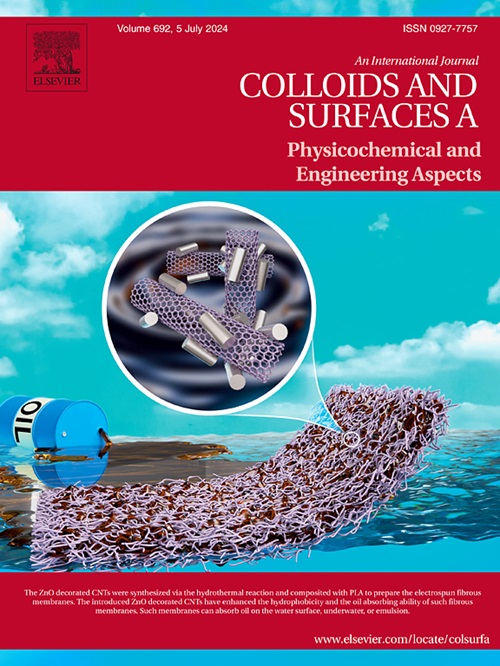Janus WSSe、WSe2和WS2材料对电力变压器绕组变形故障气体的吸附特性和传感性能比较:DFT研究
IF 5.4
2区 化学
Q2 CHEMISTRY, PHYSICAL
Colloids and Surfaces A: Physicochemical and Engineering Aspects
Pub Date : 2025-08-16
DOI:10.1016/j.colsurfa.2025.138064
引用次数: 0
摘要
本研究采用密度泛函理论(DFT)探讨了掺杂金属Mon (n = - 1)的WSSe、WSe2和WS2单分子膜的气体吸附行为和传感性能。目标气体CO、C2H2和CH4是电力变压器绕组故障的典型分解产物。为了评估WSSe的潜在优势,利用结合能(Eb)、电荷转移(Qt)、变形电荷密度(DCD)、带隙(Bg)和态密度(DOS)等参数进行了综合分析,揭示了掺杂体系的结构和电子特征。结果表明,金属Mo能显著提高三种基质的吸附性能。然后,利用吸附能(Eads)等参数研究了三种本征基质对故障气体的吸附效果。结果表明,目标气体在初始衬底上的吸附性能较差,进一步说明了金属掺杂的必要性。深入评价基体掺杂金属后吸附气体的吸附能(Eads)、电荷转移(Qt)、DCD和态密度(DOS),获得掺杂材料对目标气体的吸附和检测能力。结果表明,对气体CO吸附效果最好的3种底物为:Mo3-WSe2>Mo-WSe2>Mo2-WSSe,对气体C2H2吸附亲和力最高的3种底物为:Mo3-WSe2>Mo2-WSSe>Mo2-WSe2。气体CH4在9种基质上均表现为物理吸附,而Mo3-WSSe有可能升级为化学吸附。此外,本文还研究了水分子在衬底上的吸附,以及故障气体在衬底上的恢复时间和灵敏度,探讨了在潮湿工作环境下靶气体在衬底上的吸附,气体在九种改性衬底上的可重复使用性和响应性,以及衬底是否具有准确检测三种靶气体的能力。本研究为电力变压器绕组变形故障的设计、检测和预防提供了理论依据,也为Janus材料是否具有替代传统tmd的能力提供了参考。本文章由计算机程序翻译,如有差异,请以英文原文为准。
Comparison of the adsorption characteristics and sensing performance of Janus WSSe, WSe2 and WS2 materials for power transformer winding deformation fault gas: A DFT study
This study employs density functional theory (DFT) to explore the gas adsorption behavior and sensing performance of WSSe, WSe2, and WS2 monolayers doped with metal Mon (n = 1–3). The target gases CO, C2H2, and CH4 are typical decomposition products associated with winding faults in power transformers. To assess the potential superiority of WSSe, a comprehensive analysis was conducted using parameters such as binding energy (Eb), charge transfer (Qt), deformation charge density (DCD), band gap (Bg), and density of states (DOS) to reveal the structural and electronic features of the doped systems. The results showed that metal Mo can significantly improve the adsorption performance of the three substrates. Then, the adsorption effect of the three intrinsic substrates on the fault gas was studied using parameters such as adsorption energy (Eads). The results showed that the adsorption behavior of the target gas on the initial substrate was poor, further indicating the necessity of metal doping. The adsorption energy (Eads), charge transfer (Qt), DCD and density of states (DOS) of the adsorbed gas after the substrate was doped with metal were evaluated in depth to obtain the adsorption and detection capabilities of the doped material for the target gas. The results show that the three substrates with the best adsorption effect on gas CO are: Mo3-WSe2>Mo-WSe2>Mo2-WSSe, and the three substrates with the highest adsorption affinity for gas C2H2 are: Mo3-WSe2>Mo2-WSSe>Mo2-WSe2. Gas CH4 showed physical adsorption on all nine substrates, and Mo3-WSSe has the potential to be upgraded to chemical adsorption. In addition, the article also studied the adsorption of water molecules on the substrate, as well as the recovery time and sensitivity of the fault gas on the substrate, to explore the adsorption of the target gas on the substrate in a humid working environment, the reusability and responsiveness of the gas on the nine modified substrates, and whether the substrate has the ability to accurately detect the three target gases. This study provides a theoretical basis for the design, detection and prevention of deformation faults of power transformer windings, and also provides a reference for whether Janus materials have the ability to replace traditional TMDs.
求助全文
通过发布文献求助,成功后即可免费获取论文全文。
去求助
来源期刊
CiteScore
8.70
自引率
9.60%
发文量
2421
审稿时长
56 days
期刊介绍:
Colloids and Surfaces A: Physicochemical and Engineering Aspects is an international journal devoted to the science underlying applications of colloids and interfacial phenomena.
The journal aims at publishing high quality research papers featuring new materials or new insights into the role of colloid and interface science in (for example) food, energy, minerals processing, pharmaceuticals or the environment.

 求助内容:
求助内容: 应助结果提醒方式:
应助结果提醒方式:


